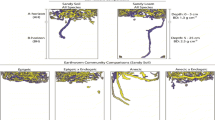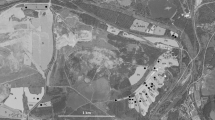Abstract
In northern boreal forests the occurrence of endogeic and anecic earthworms is determined by soil pH. Increasing evidence suggests that large detritivorous soil animals such as earthworms can influence the other components of the decomposer community. To study the effects of earthworms and pH on soil nematode and enchytraeid communities, a factorially designed experiment was conducted with Lumbricus rubellus and/or Aporrectodea caliginosa. Earthworms were added to "mesocosms" containing unlimed (pH 4.8) or limed (pH 6.1) coniferous mor humus with their natural biota of micro-organisms. In the absence of earthworms, nematodes were significantly more abundant in limed than in unlimed humus. Earthworms markedly decreased the numbers of nematodes both in unlimed and limed soils. Earthworm activities eliminated enchytraeids in unlimed soil, but liming improved the survival of some species. It was concluded that liming of soil, either alone or mediated by the earthworm populations, is likely to affect soil nematode and enchytraeid community and mineralisation.




Similar content being viewed by others
References
Abrahamsen G (1973a) Biomass and body-surface area of populations of Enchytraeidae and Lumbricidae (Oligochaeta) in Norwegian coniferous forest soils. Pedobiologia 13:28–39
Abrahamsen G (1973b) Studies on body-volume, body-surface area, density and live weight of Enchytraeidae (Oligochaeta). Pedobiologia 13:6–15
Abrahamsen G (1990) Influence of Cognettia shagnetorum (Oligochaeta: Enchytraeidae) on nitrogen mineralization in homogenized mor humus. Biol Fertil Soils 9:159–162
Anderson JPE, Domsch KH (1978) A physiological method for the quantitative measurement of microbial biomass in soils. Soil Biol Biochem 10:215–221
Bassus W (1960) Die nematodenfauna des fichtenrohhumus unter dem einfluß der kalkdüngung. Nematologica 5:86–91
Bongers T (1990) The maturity index: an ecological measure of environmental disturbance based on nematode species composition. Oecologia 83:14–19
Cajander AK (1949) Forest types and their significance. Acta For Fenn 56:1–71
Chapman K, Whittaker JB, Heal OW (1988) Metabolic and faunal activity in litters of tree mixtures compared with pure stands. Agric Ecosyst Environ 24:33–40
Cole L, Bardgett RD, Ineson P (2000) Enchytraeid worms (Oligochaeta) enhance mineralization of carbon in organic upland soils. Eur J Soil Sci 51:185–192
Curry JP (1998) Factors affecting earthworm abundance in soils. In: Edwards CA (ed) Earthworm ecology. St. Lucie Press, Boca Raton, Fla., pp 37–64
Dash MC, Senapati BK, Mishra CC (1980) Nematode feeding by tropical earthworms. Oikos 34:322–325
Didden WAM (1993) Ecology of terrestrial Enchytraeidae. Pedobiologia 37:2–29
Edwards CA, Bohlen PJ (1996) Biology and ecology of earthworms. Chapman & Hall, London
Elliot ET, Anderson RV, Coleman DC, Cole CV (1980) Habitable pore space and microbial trophic interactions. Oikos 35:327–335
Franz H (1959) Das biologische Geschehen im Waldboden und seine Beeinflussung durch die Kalkdüngung. Allg Forstztg 70:178–181
Graefe U (1989) Der Einfluß von sauren Niederschlägen und Bestandeskalkungen auf die Enchytraeidenfauna in Waldböden. Gesell Okol 17:597–603
Griffiths BS, Bardgett RD (1997) Interactions between microbe-feeding invertebrates and soil microorganisms. In: van Elsas JD, Wellington E, Trevors JT (eds) Modern soil microbiology. Dekker, New York, pp 165–182
Huhta V (1979) Effects of liming and deciduous litter on earthworm (Lumbricidae) populations of a spruce forest, with an inoculation experiment on Aporrectodea caliginosa. Pedobiologia 19:340–345
Huhta V (1984) Response of Cognettia sphagnetorum (Enchytraeidae) to manipulation of pH and nutrient status in coniferous forest soil. Pedobiologia 27:245–260
Huhta V (2002) Soil macroarthropod communities in planted birch stands in comparison with natural forests in central Finland. Appl Soil Ecol 20:199–209
Huhta V, Niemi R (2003) Communities of soil mites (Acarina) in planted birch stands as compared with natural forests in central Finland. Can J For Res (in press)
Huhta V, Viberg K (1999) Competitive interactions between the earthworm Dendrobaena octaedra and the enchytraeid Cognettia sphagnetorum. Pedobiologia 43:886–890
Huhta V, Hyvönen R, Kaasalainen P, Koskenniemi A, Muona J, Mäkelä I, Sulander M, Vilkamaa P (1986) Soil fauna in Finnish coniferous forests. Ann Zool Fenn 23:345–360
Hyvönen R, Huhta V (1989) Effects of lime, ash and nitrogen fertilizers on nematode populations on Scots Pine forest soils. Pedobiologia 33:129–143
Hyvönen R, Persson T (1990) Effects of acidification and liming on feeding groups of nematodes in coniferous forest soil. Biol Fertil Soils 9:205–210
Hyvönen R, Andersson S, Clarholm M, Persson T (1994) Effects of lumbricids and enchytraeids on nematodes in limed and unlimed coniferous mor humus. Biol Fertil Soils 17:201–205
Killham K (1994) Soil ecology. Cambridge University Press, Cambridge
Laakso J, Setälä H (1998) Composition and trophic structure of detrital food web in ant nest mounds of Formica aquilonia and in the surrounding forest soil. Oikos 81:266–278
Lavelle C, Spain AV (2002) Soil ecology. Kluwer, Dordrecht
Lundkvist H (1981) Population dynamics of Cognettia sphagnetorum (Enchytraeidae) in a Scots pine forest soil in Central Sweden. Pedobiologia 22:21–41
McCune B, Mefford MJ (1999) PC-ORD—Multivariate analysis of ecological data, version 4. Gleneden Beach, Oregon, USA. MjM Software Design, Livingston
Munt'yan NA, Korol'chuk VV, Lazar IS (1969) On the relationships of earthworms with the root parasites of plants. Izv Akad Nauk Mold SSR Ser Biol Khim Nauk 5:67–71
Nielsen CO, Christensen B (1959) The Enchytraeidae. Critical revision and taxonomy of European species. Nat Jutl 8–9:1–160
Nielsen CO, Christensen B (1961) The Enchytraeidae. Critical revision and taxonomy of European species. Suppl. 1. Nat Jutl 10:1–23
Nielsen CO, Christensen B (1963) The Enchytraeidae. Critical revision and taxonomy of European species. Suppl. 2. Nat Jutl 10:1–19
Nordén U (1994) Influence of broad-leaved tree species on pH and organic matter content of forest topsoils in Scania, South Sweden. Scand J For Res 9:1–8
O'Connor FB (1962) The extraction of Enchytraeidae from soil. In: Murphy PW (ed) Progress in soil zoology. Butterworths, London, pp 279–285
Persson T, Bååth E, Clarholm M, Lundkvist H, Söderström BE, Sohlenius B (1980) Trophic structure, biomass dynamics and carbon metabolism of soil organisms in a Scots pine forest. In: Persson T (ed) Structure and function of northern coniferous forests—an ecosystem study. Ecological Bulletin Stockholm, pp 419–459
Petersen H, Luxton, M (1982) A comparative analysis of soil fauna populations and their role in decomposition processes. Oikos 39:287–388
Pielou EC (1975) Ecological diversity. Wiley, New York
Priha O (1999) Microbial activities in soil under Scots pine, Norway spruce and silver birch. (Research papers 731) Finnish Forest Research Institute, Helsinki
Richards BN (1987) The microbiology of terrestrial ecosystems. Longmann, Harlow
Standen V (1980) Factors affecting the distribution of Enchytraeidae (Oligochaeta) in associations at peat and mineral sites in northern England. Bull Ecol 11:599–608
Stöp-Bowitz C (1969) A contribution to our knowledge of the systematics and zoogeography of Norwegian earthworms (Annelida Oligochaeta: Lumbricidae). Nytt Mag Zool 17:169–280
Willis KJ, Braun M, Sümegi P, Tóth A (1997) Does soil change cause vegetation change or vice versa? A temporal perspective from Hungary. Ecology 78:740–750
Yeates GW (1981) Soil nematode populations depressed in the presence of earthworms. Pedobiologia 22:191–195
Yeates GW (1984) Variation in soil nematode diversity under pasture with soil and year. Soil Biol Biochem 16:95–102
Yeates GW (1994) Modification and qualification of the nematode maturity index. Pedobiologia 38:97–101
Yeates GW, King KL (1997) Soil nematodes as indicators of the effect of management on grasslands in the New England Tablelands (NSW): comparison of native and improved grasslands. Pedobiologia 41:526–536
Yeates GW, Bongers T, De Goede RGM, Freckman DW, Georgieva SS (1993) Feeding habits in soil nematode families and genera—an outline for soil ecologists. J Nematol 25:315–331
Acknowledgements
The authors thank Mustapha Boucelham, Leena Kontiola and Aisling O'Shea for assisting in the experimental work, Prof. Dr. Klára Dózsa-Farkas for invaluable help in taxonomy of Enchytraeidae and Dr. Joann von Weissenberg for revising the English language. The support of the Konnevesi Research Station, University of Jyväskylä, is also acknowledged. This study was funded by the Academy of Finland and the foundation Metsämiesten Säätiö.
Author information
Authors and Affiliations
Corresponding author
Rights and permissions
About this article
Cite this article
Räty, M., Huhta, V. Earthworms and pH affect communities of nematodes and enchytraeids in forest soil. Biol Fertil Soils 38, 52–58 (2003). https://doi.org/10.1007/s00374-003-0614-5
Received:
Accepted:
Published:
Issue Date:
DOI: https://doi.org/10.1007/s00374-003-0614-5




